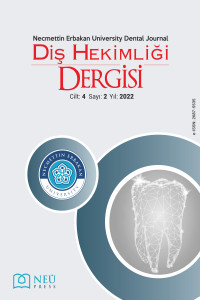Çocuk Diş Hekimliği Kliniğine Yapılan Başvuruların Retrospektif Değerlendirilmesi: 5 Yıl Karşısında COVID-19 Pandemisiyle 3 ay
Amaç: Ağız ve diş sağlığının sürdürülebilmesi için düzenli diş hekimi muayenesi, varsa patolojilerin belirlenmesi ve herhangibir ağrı olmadan sorunların tespit ve tedavisinin yapılması gereklidir. İstisnai olarak bulaş riskinden dolayı alınan önlemlerkapsamında acil olmayan diş tedavilerinin geçici bir süreyle ertelenmesi söz konusu olmuştur. Bu çalışmada COVID-19 virüsünedeniyle pandemi süreci olarak nitelendirdiğimiz 3 aylık dönemde hasta başvurularının ve yapılan işlem sayılarının geçtiğimiz sene ortalamaları ile kıyaslanması amaçlanmıştır.Gereç ve Yöntemler: Bu çalışmada Ocak 2015 ve Aralık 2019 ile 11 Mart 2020 ile 11 Haziran 2020 tarihleri arasında bir çocuk diş hekimliği kliniğine başvuran 0-16 yaş arası hastalar retrospektif olarak incelenmiştir. Ortalamalarının kıyaslamalarıiçin ANOVA testi kullanılmış, demografik veriler frekans ve ortalama olarak verilmiştir.Bulgular: 0-16 yaş arası toplam 65.443 hasta için 138.466 başvuru olduğu görülmüştür. Bu hastaların 32.508’i kız (%49,67),32.935’i erkektir (%50,33). Yaş ortalaması 9,06 olarak hesaplanmıştır. Başvuru sayısı ortalaması 2015-2019 arası aylık 2.284olarak hesaplanırken, 3 aylık pandemi sürecinde bu ortalama aylık 467’ye düşmüştür. Diş çekimi sayısı daha önceki yıllıkortalamaların yaklaşık dörtte birine düşmüşken, koruyucu işlemlerin sayısı yaklaşık 10-14 kat kadar azalmıştır.Sonuç: Bulaş riskinin azaltılması amacıyla acil olmayan tedaviler dışında tüm tedavilerin ertelendiği bu olağanüstü süreçte,hasta koltuk sürelerinin azaltılması ve işlemlerin daha az aerosol salınımına neden olması gerektiği bildirilmiştir. Bu sürecintamamlanmasından sonra da bu önlemlerin sürdürülmesi için bu doğrultuda çalışmalara ihtiyaç duyulacaktadır. COVID-19sonrasında da bulaş riski çok yüksek bir alan olan diş hekimliğinde tedavi amaç ve yöntemleri gözden geçirilecektir.
Anahtar Kelimeler:
Başvuru, covid-19, çocuk diş hekimliği, pandemi
Retrospective Evaluation of Applications to the Paediatric Dentistry Clinic: 3 months with COVID-19 Pandemic vs. 5 Years
Objective: In order to maintain oral and dental health, it is necessary to perform regular dental examinations, to determinepathologies to identify and treat problems painlessly. Recently, non-emergency dental treatments were temporarily postponed due to the risk of transmission. We aimed to compare average number of patient visits and procedures performed in the3-month COVID-19 pandemic period with the averages of the last 5 years.Material and Methods: Patients aging between 0-16, who applied to a paediatric dentistry clinic between January 2015 andDecember 2019, and 11 March 2020 and 11 June 2020 were analyzed retrospectively. ANOVA test was used for comparingthe averages.Results: There were 138,466 applications for a total of 65,443 patients. Females were 32,508 (49.67%), and males were32,935 (50.33%). The average age was 9.06. While the average application number was 2,284 per month between 2015 and2019, it decreased to 467 per month during the 3-month pandemic period.Conclusion: In this extraordinary process, in which all non-emergency treatments were postponed, treatment time should bereduced to decrease the amount of aerosol emissions. After the completion of this process, similar studies are required toensure that the measures continue. After COVID-19, goals and methods of treatment will be reviewed in dentistry, which is afield with a high risk of transmission.
Keywords:
Application, covid-19, paediatric dentistry, pandemic,
___
- Kassebaum NJ, Bernabé E, Dahiya M, Bhandari B, Murray CJ, Marcenes W. Global burden of untreated caries: a systematic review and metaregression. J Dent Res. 2015;94:650–8.
- Benjamin RM. Oral health: the silent epidemic. Public Health Rep. 2010;125:158–9.
- Glendor U. Epidemiology of traumatic dental injuries—a 12 year review of the literature. Dent Traumatol. 2008. December;24(6):603–11.
- Trulsson U, Klingberg G. Living with a child with a severe orofacial handicap: experiences from the perspectives of parents. Eur J Oral Sci. 2003;111:19–25.
- Monse B, Heinrich-Weltzien R, Benzian H, Holmgren C, van Palenstein Helderman WH: PUFA – An index of clinical consequences of untreated dental caries. Community Dent Oral Epidemiol. 2010, 38: 77-82.
- Mathur VP, Dhillon JK. Dental Caries: A Disease Which Needs Attention. Indian J Pediatr. 2018;85(3):202-6.
- Mika A, Mitus-Kenig M, Zeglen A, Drapella-Gasior D, Rutkowska K, Josko-Ochojska J. The child's first dental visit. Age, reasons, oral health status and dental treatment needs among children in Southern Poland. Eur J Paediatr Dent. 2018;19(4):265-270.
- Cucinotta D, Vanelli M. WHO Declares COVID-19 a Pandemic. Acta Biomed. 2020;91(1):157-160.
- Volgenant CMC, de Soet JJ. Cross-transmission in the dental office: does this make you ill? Curr Oral Health Rep. 2018; 5(4): 221-8.
- Peng X, Xu X, Li Y, Cheng L, Zhou X, Ren B. Transmission routes of 2019-nCoV and controls in dental practice. Int J Oral Sci. 2020; 12(1): 9.
- Meng L, Hua F, Bian Z. Coronavirus disease 2019 (COVID-19): Emerging and future challenges for dental and oral medicine. J Dent Res. 2020; 99(5): 481-7.
- Kamu Hastaneleri Genel Müdürlüğü Sağlık Hizmetleri Dairesi Başkanlığı. COVID-19 Salgını Sırasında Dental İşlemlerde Uyulması Gereken Prosedürler [İnternet]. Ankara: Sağlık Bakanlığı https://khgmsaglikhizmetleridb.saglik. gov.tr/TR,64871/covid-19-salgini-sirasinda-dental-islemlerdeuyulmasi-gereken-prosedurler.html.
- Yayın Aralığı: Yılda 3 Sayı
- Başlangıç: 2019
- Yayıncı: Necmettin Erbakan Üniversitesi
Sayıdaki Diğer Makaleler
Sinem SIRLI YILMAZTÜRK, Özlem YARBAŞI, Esin BOZDEMİR (HAŞTAR)
Dilek ÖZKAN ŞEN, Betül IRIZ, Fatma UCAN YARKAC, Elif ÖNCÜ
Hazal ÖZER, Merve ABAKLI İNCİ, Onur AĞMAZ
Hafta İçi Günlerde Çene Cerrahisi Kliniğine Başvuran Hasta Sayısının Değerlendirilmesi
Dilek MENZİLETOĞLU, Fatima YUSİFLİ, Şebnem AKKÜLAH
Komplike Kron-Kök Kırıklı Bir Dişin Konservatif Tedavisi: Göreceli Başarı
Şeref Nur MUTLU, Makbule Bilge AKBULUT, Ayçe ÜNVERDİ ELDENİZ
